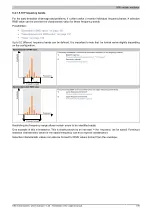
X90 mobile modules
176
X90 mobile system User's manual V 1.20 - Translation of the original manual
5.4.1.5.7.4 K(t) value
The K(t) is described in the VDI 3832 guideline and is calculated from the RMS value and the absolute maximum of
a broadband time signal of the oscillation acceleration. For the time signal, the entire available frequency spectrum
is used for calculation.
This ratio correlates to the reference values. The reference values should be measured by the operator shortly
after the running-in time. These values can be classified as "Plant in order" and are therefore the initial values.
The K(t) value decreases with progressive wear. This allows it to be classified into 3 groups:
•
Undamaged
•
Early damage
•
Pronounced damage
The advantage of the K(t) value is that does not change much, even when damage is severe.
K(t) =
ɑ
ɑ
RMS
p
(0)
(0)
·
(t):
ɑ
ɑ
RMS
p
(t)
The following applies:
Formula symbols
Explanation
Characteristic value in the module
ɑ
rms
(0)
RMS value of the reference value
RmsHighFrequencyRef
RmsRawRef
ɑ
p
(0)
Maximum value of the reference value
PeakHighFrequencyRef
PeakRawRef
ɑ
rms
(t)
Current RMS value
RmsHighFrequency
RmsRaw
ɑ
p
(t)
Current absolute maximum
PeakHighFrequency
ReakRaw
Example
Possible progression of the (K/t) characteristic value
K(t) [1]
Time [t]
Possible running-in time
1
Figure 39: K(t) value progression
Vdi3832KtHighFrequency
Name:
Vdi3832KtHighFrequency01 to Vdi3832KtHighFrequency04
Registers for reading the high-pass K(t) value (per VDI 3832 guideline) of the respective channel.
Vdi3832KtHighFrequency is formed from the peak value (
"PeakHighFrequency" on page 171
) and RMS value
(
"RmsHighFrequency" on page 173
) of the high-pass filtered input signal and the vibration acceleration in the
frequency range between the value set in register
"HighFrequencyConfig" on page 185
and 10 kHz.
Format
Unit
REAL
1
















































